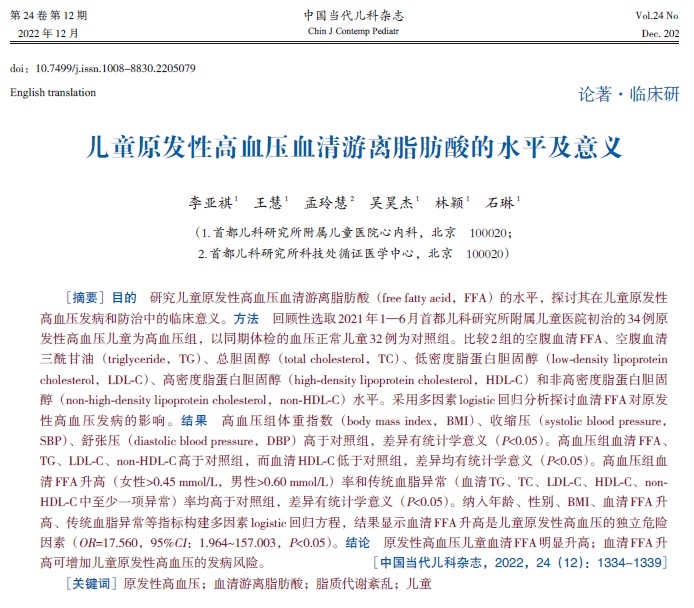目的 探讨学龄前儿童感染严重急性呼吸综合征冠状病毒-2(severe acute respiratory syndrome coronavirus 2,SARS-CoV-2)Omicron变异株后的相关持续症状,为制订感染后的随访计划,减少和预防患儿感染后的相关症状提供依据。 方法 以2022年4月13日—5月8日由上海市仁济医院南院儿科病房出院的0~5岁Omicron BA.2感染的患儿为研究对象,收集人口学及临床资料,并以连续2次、间隔时间超过24 h的SARS-CoV-2核酸转阴时间为随访起点,其转阴后的4~5周为随访截点,对主要带养人进行电话随访,了解患儿出院后相关持续症状。 结果 符合纳入条件的103例患儿中,男孩61例,女孩42例,中位年龄为18个月。主要带养家长已接种2针及以上新型冠状病毒肺炎(coronavirus disease 2019,COVID-19)疫苗的比例为64.1%(66/103)。患儿最常见的症状为发热(98.1%,101/103),其次是咳嗽/咳痰(63.1%,65/103)、胃肠道问题(37.9%,39/103)、食欲下降(30.1%,31/103)、乏力(27.2%,28/103)、鼻塞/流涕(16.5%,17/103)等。出院1个月时随访报告44例(42.7%)至少有1种持续症状,包括呼吸道相关症状(14例,13.6%)、胃肠道问题(19例,18.4%)等。主要带养人接种2针及以上COVID-19疫苗的患儿SARS-CoV-2核酸转阴时间较家长未接种或接种1针的患儿核酸转阴时间缩短(P<0.05),但2组患儿存在至少1种持续症状的比例差异无统计学意义(P>0.05)。 结论 近半数SARS-CoV-2 Omicron变异株感染学龄前儿童出院后存在持续相关症状,多为胃肠道症状和呼吸道症状,但大部分症状轻微,需持续随访关注其转归情况。主要带养人COVID-19疫苗接种对儿童可起到一定的保护作用。
Abstract
Objective To investigate the persistent symptoms in preschool children after severe acute respiratory syndrome coronavirus 2 (SARS-CoV-2) Omicron variant infection, and to provide a basis for developing follow-up plans after infection and reducing and preventing related symptoms after infection. Methods The children, aged 0-5 years, who had Omicron BA.2 infection and were discharged from the pediatric ward of Shanghai Renji Hospital South Branch from April 13 to May 8, 2022, were enrolled as subjects, and related demographic and clinical data were collected. The children were followed up from the time to SARS-CoV-2 clearance for two consecutive tests with an interval of >24 hours till 4-5 weeks after clearance, and telephone follow-up was performed on the primary caregivers to investigate related persistent symptoms. Results Among the 103 children who met the inclusion criteria, there were 61 boys and 42 girls, with a median age of 18 months. The primary caregivers who had received two or more doses of COVID-19 vaccine accounted for 64.1% (66/103). Fever (98.1%, 101/103) was the most common symptom in these children, followed by cough/expectoration (63.1%, 65/103), gastrointestinal problems (37.9%, 39/103), loss of appetite (30.1%, 31/103), weakness (27.2%, 28/103), and nasal obstruction/runny nose (16.5%, 17/103). The follow-up at 1 month after discharge reported that 44 children (42.7%) had at least one persistent symptom, including respiratory symptoms in 14 children (13.6%) and gastrointestinal problems in 19 children (18.4%). The children whose primary caregivers received two or more doses of COVID-19 vaccine had a significantly shorter time to SARS-CoV-2 clearance than those whose primary caregivers did not receive or only received one dose of COVID-19 vaccine (P<0.05), while there was no significant difference between the two groups in the proportion of children with at least one persistent symptom (P>0.05). Conclusions Nearly half of the preschool children may have related persistent symptoms after SARS-CoV-2 Omicron variant infection, mainly gastrointestinal and respiratory symptoms. Most of the symptoms may be mild, and continuous follow-up is needed to observe their outcomes. Vaccination of COVID-19 vaccine for primary caregivers has a certain protective effect on children.
关键词
新型冠状病毒肺炎 /
严重急性呼吸综合征冠状病毒-2 /
Omicron变异株 /
症状 /
随访 /
疫苗接种 /
学龄前儿童
Key words
Coronavirus disease 2019 /
Severe acute respiratory syndrome coronavirus 2 /
Omicron variant /
Symptom /
Follow-up /
Vaccination /
Preschool child
{{custom_sec.title}}
{{custom_sec.title}}
{{custom_sec.content}}
参考文献
1 World Health Organization. Weekly epidemiological update on COVID-19—1 June 2022[EB/OL]. (2022-06-01)[2022-06-01]. https://www.who.int/publications/m/item/weekly-epidemiological-update-on-covid-19---1-june-2022.
2 Castagnoli R, Votto M, Licari A, et al. Severe acute respiratory syndrome coronavirus 2 (SARS-CoV-2) infection in children and adolescents: a systematic review[J]. JAMA Pediatr, 2020, 174(9): 882-889. PMID: 32320004. DOI: 10.1001/jamapediatrics.2020.1467.
3 Wang L, Berger NA, Kaelber DC, et al. Incidence rates and clinical outcomes of SARS-CoV-2 infection with the Omicron and Delta variants in children younger than 5 years in the US[J]. JAMA Pediatr, 2022, 176(8): 811-813. PMID: 35363246. PMCID: PMC8976262. DOI: 10.1001/jamapediatrics.2022.0945.
4 Payne AB, Gilani Z, Godfred-Cato S, et al. Incidence of multisystem inflammatory syndrome in children among US persons infected with SARS-CoV-2[J]. JAMA Netw Open, 2021, 4(6): e2116420. PMID: 34110391. PMCID: PMC8193431. DOI: 10.1001/jamanetworkopen.2021.16420.
5 National Institute for Health and Care Excellence. COVID-19 rapid guideline: managing the long-term effects of COVID-19[EB/OL]. (2021-11-11)[2022-06-02]. https://www.nice.org.uk/guidance/ng188?UID=560726542202210172134.
6 Borch L, Holm M, Knudsen M, et al. Long COVID symptoms and duration in SARS-CoV-2 positive children: a nationwide cohort study[J]. Eur J Pediatr, 2022, 181(4): 1597-1607. PMID: 35000003. PMCID: PMC8742700. DOI: 10.1007/s00431-021-04345-z.
7 Zhang X, Zhang W, Chen S. Shanghai's life-saving efforts against the current Omicron wave of the COVID-19 pandemic[J]. Lancet, 2022, 399(10340): 2011-2012. PMID: 35533708. PMCID: PMC9075855. DOI: 10.1016/S0140-6736(22)00838-8.
8 中华人民共和国国家卫生健康委员会医政医管局. 关于印发新型冠状病毒肺炎诊疗方案(试行第九版)的通知: 国卫办医函〔2022〕71号[EB/OL]. (2022-03-15)[2022-06-01]. http://www.nhc.gov.cn/yzygj/s7653p/202203/b74ade1ba4494583805a3d2e40093d88.shtml.
9 Wang L, Berger NA, Kaelber DC, et al. COVID infection severity in children under 5 years old before and after Omicron emergence in the US[J]. medRxiv[Preprint]. (2022-01-13) [2022-06-02]. PMID: 35043116. PMCID: PMC8764724. DOI: 10.1101/2022.01.12.22269179.
10 Nikolopoulou GB, Maltezou HC. COVID-19 in children: where do we stand?[J]. Arch Med Res, 2022, 53(1): 1-8. PMID: 34311990. PMCID: PMC8257427. DOI: 10.1016/j.arcmed.2021.07.002.
11 Menni C, Valdes AM, Polidori L, et al. Symptom prevalence, duration, and risk of hospital admission in individuals infected with SARS-CoV-2 during periods of Omicron and Delta variant dominance: a prospective observational study from the ZOE COVID Study[J]. Lancet, 2022, 399(10335): 1618-1624. PMID: 35397851. PMCID: PMC8989396. DOI: 10.1016/S0140-6736(22)00327-0.
12 Zimmermann P, Pittet LF, Curtis N. How common is long COVID in children and adolescents?[J]. Pediatr Infect Dis J, 2021, 40(12): e482-e487. PMID: 34870392. PMCID: PMC8575095. DOI: 10.1097/INF.0000000000003328.
13 Brewster RC, Parsons C, Laird-Gion J, et al. COVID-19-associated croup in children[J]. Pediatrics, 2022, 149(6): e2022056492. PMID: 35257175. DOI: 10.1542/peds.2022-056492.
14 Wang L, Berger NA, Kaelber DC, et al. COVID infection rates, clinical outcomes, and racial/ethnic and gender disparities before and after Omicron emerged in the US[J]. medRxiv[Preprint]. (2022-02-22) [2022-06-02]. PMID: 35233579. PMCID: PMC8887070. DOI: 10.1101/2022.02.21.22271300.
15 Zhang J, Chen N, Zhao D, et al. Clinical characteristics of COVID-19 patients infected by the Omicron variant of SARS-CoV-2[J]. Front Med (Lausanne), 2022, 9: 912367. PMID: 35615088. PMCID: PMC9125333. DOI: 10.3389/fmed.2022.912367.
16 Puhach O, Adea K, Hulo N, et al. Infectious viral load in unvaccinated and vaccinated individuals infected with ancestral, Delta or Omicron SARS-CoV-2[J]. Nat Med, 2022, 28(7): 1491-1500. PMID: 35395151. DOI: 10.1038/s41591-022-01816-0.
17 Centers for Disease Control and Prevention. Information for healthcare providers about multisystem inflammatory syndrome in children (MIS-C)[EB/OL]. (2021-05-20)[2022-07-07]. https://www.cdc.gov/mis/mis-c/hcp/.
基金
“十四五”国家重点研发计划(2021YFC2701800;2021YFC2701801)。
 PDF(540 KB)
PDF(540 KB)


 PDF(540 KB)
PDF(540 KB)
 PDF(540 KB)
PDF(540 KB)
